Changes in the Pattern of Weekdays Electricity Real Consumption during the COVID-19 Crisis
Abstract
1. Introduction
2. Literature Review
3. Data and Methodology
3.1. Methodology
- —is electricity real consumption for weekday d ∈ {Monday, Tuesday, Wednesday, Thursday, Friday} and time interval t, t = 1 for 0:00–0:59 interval, …, t = 24 for 23:00–23:59 interval.
- —is electricity real consumption for weekend day s ∈ {Saturday, or Sunday}, and time interval t, so that t = 1 for 0:00–0:59 interval, …, t = 24 for 23:00–23:59 interval.
| The coefficients of correlation: | |
| The Manhattan distance (the Euclidian 1-norm): | |
| The cosine of the angle between the structure vectors (uncentered coefficient of correlation) … | |
| … and the angle between the structure vectors: | αds = arccos[cos(hd, hs)] |
| The Mahalanobis distance |
- Non-COVID19 time (1 January 2006–15 March 2020).
- State of emergency (16 March 2020–14 May 2020).
- State of alert (15 May 2020–8 March 2022).
3.2. Data
“Transelectrica is the Romanian Transmission and System Operator which plays a key role in the Romanian electricity market. (…) Transelectrica is responsible for electricity transmission, system, and market operation, grid and market infrastructure development ensuring the security of the Romanian power system. It also serves as the main link between electricity supply and demand, matching all the time power generation with demand”. (https://www.transelectrica.ro/en/web/tel/despre-noi1, accessed on 23 April 2022).
4. Results
5. Conclusions
Author Contributions
Funding
Data Availability Statement
Conflicts of Interest
References
- Glennerster, R.; Snyder, C.M.; Tan, B.J. Calculating the Costs and Benefits of Advance Preparations for Future Pandemics; Working Paper 30565; National Bureau of Economic Research (NBER): Cambridge, MA, USA, 2022. [Google Scholar] [CrossRef]
- National Institute of Statistics. National Accounts. Quarterly Gross Domestic Product (Tables CON104J and CON104N). 2022. Available online: http://statistici.insse.ro:8077/tempo-online/#/pages/tables/insse-table (accessed on 6 May 2022).
- National Institute of Statistics. Energy. Energy Balances by Component Elements (Table IND108A). 2022. Available online: http://statistici.insse.ro:8077/tempo-online/#/pages/tables/insse-table (accessed on 6 May 2022).
- The Economist. Tracking COVID-19 Excess Deaths Across Countries. Available online: https://www.economist.com/graphic-detail/coronavirus-excess-deaths-tracker (accessed on 28 November 2022).
- Biederman, I. Recognition-by-components: A Theory of human image understanding. Psychol. Rev. 1987, 94, 115–147. [Google Scholar] [CrossRef] [PubMed]
- Da Fontoura Costa, L.; Cesar, R.M. Shape Analysis and Classification: Theory and Practice; CRC Press: Boca Raton, FL, USA, 2000. [Google Scholar]
- Batley, S. Classification in Theory and Practice, 2nd ed.; Elsevier: Amsterdam, The Netherlands, 2015. [Google Scholar] [CrossRef]
- Parrochia, D. Classification; Fieser, J., Dowden, B., Eds.; The Internet Encyclopedia of Philosophy: USA, 2016; Available online: https://iep.utm.edu/classification-in-science/ (accessed on 5 November 2022).
- Bishop, C.M. Pattern Recognition and Machine Learning; Springer: Berlin/Heidelberg, Germany, 2007. [Google Scholar]
- Banoula, M. Classification in Machine Learning: What It Is and Classification Models. AI & Machine Learning. Available online: https://www.simplilearn.com/tutorials/machine-learning-tutorial/classification-in-machine-learning (accessed on 25 November 2022).
- Yang, T.; Gerasoulis, A. Web Search Engines: Practice and Experience. In Computer Handbook: Computer Science and Software Engineering, 3rd ed.; Tucker, A., Gonzalez, T., Topi, H., Diaz-Herrera, J., Eds.; Taylor and Francis Group/CRC Press: Boca Raton, FL, USA, 2014; p. 24. Available online: https://sites.cs.ucsb.edu/~tyang/papers/bookchaptersearch.pdf (accessed on 5 November 2022).
- Kameni Homte, J.S.; Batchakui, B.; Nkambou, R. Search Engines in Learning Contexts: A Literature Review. Int. J. Emerg. Technol. Learn. 2022, 17, 254–272. [Google Scholar] [CrossRef]
- Han, J.; Kamber, M.; Pei, J. Data Mining: Concepts and Techniques, 3rd ed.; Elsevier: Amsterdam, The Netherlands, 2012. [Google Scholar]
- Tan, P.-N.; Steinbach, M.; Karpatne, A.; Kumar, V. Introduction to Data Mining, 2nd ed.; Pearson: London, UK, 2018. [Google Scholar]
- Hjørland, B.; Pedersen, K.N. A substantive theory of classification for information retrieval. J. Doc. 2005, 61, 582–597. [Google Scholar] [CrossRef]
- Russell, S.; Norvig, P. Artificial Intelligence: A Modern Approach, 4th ed.; Pearson: London, UK, 2020. [Google Scholar]
- Manyika, J. Getting AI Right: Introductory Notes on AI & Society. Daedalus 2022, 151, 5–27. [Google Scholar] [CrossRef]
- Nicola, M.; Alsafi, Z.; Sohrabi, C.; Kerwan, A.; Al-Jabir, A.; Iosifidis, C.; Agha, R. The socio-economic implications of the coronavirus pandemic (COVID-19): A review. Int. J. Surg. 2020, 78, 185–193. [Google Scholar] [CrossRef]
- Alshater, M.M.; Atayah, O.F.; Khan, A. What do we know about business and economics research during COVID-19: A bibliometric review. Econ. Res. 2021, 29, 1884–1912. [Google Scholar] [CrossRef]
- Brodeur, A.; Gray, D.; Islam, A.; Suraiya, B. A literature review of the economics of COVID-19. J. Econ. Surv. 2021, 35, 1007–1044. [Google Scholar] [CrossRef]
- Callegari, B.; Feder, C. A Literature Review of Pandemics and Development: The Long-Term Perspective. Econ. Disasters Clim. Chang. 2022, 6, 183–212. [Google Scholar] [CrossRef]
- Podolsky, M.I.; Present, I.; Neumann, P.J.; Kim, D.D. A Systematic Review of Economic Evaluations of COVID-19 Interventions: Considerations of Non-health Impacts and Distributional Issues. Value Health 2022, 25, 1298–1306. [Google Scholar] [CrossRef]
- de Oliveira Coutinho, C.; Mota, T.M.L.; Santos, L.P.; da Silva, T.S.; Conde, T.N.; Mulder, A.D.R.P.; Seixas, C.M. The impact of the COVID-19 pandemic on eating disorders and their treatment: An integrative literature review. Res. Soc. Dev. 2021, 10, 14. [Google Scholar] [CrossRef]
- Şevgin, Ö.; Alptekin, H.K.; Şevgin, K. The Weak Ring of the COVID-19 Pandemic: The Elderly (A Literature Review). Geriatr. Med. Gerontol. 2021, 7, 7. [Google Scholar] [CrossRef]
- Rana, R.H.; Keramat, S.A.; Gow, J. A Systematic Literature Review of the Impact of COVID-19 Lockdowns on Air Quality in China. Aerosol Air Qual. Res. 2021, 21, 20. [Google Scholar] [CrossRef]
- Khlystova, O.; Kalyuzhnova, Y.; Belitski, M. The impact of the COVID-19 pandemic on the creative industries: A literature review and future research agenda. J. Bus. Res. 2022, 139, 1192–1210. [Google Scholar] [CrossRef] [PubMed]
- Haafza, L.A.; Awan, M.J.; Abid, A.; Yasin, A.; Nobanee, H.; Farooq, M.S. Big Data COVID-19 Systematic Literature Review: Pandemic Crisis. Electronics 2021, 10, 3125. [Google Scholar] [CrossRef]
- Gunasekeran, D.V.; Chew, A.; Chandrasekar, E.K.; Rajendram, P.; Kandarpa, V.; Rajendram, M.; Chia, A.; Smith, H.; Leong, C.K. The Impact and Applications of Social Media Platforms for Public Health Responses before and during the COVID-19 Pandemic: Systematic Literature Review. J. Med. Internet Res. 2022, 24, e33680. [Google Scholar] [CrossRef]
- Cachón-Zagalaz, J.; Sánchez-Zafra, M.; Sanabrias-Moreno, D.; González-Valero, G.; Lara-Sánchez, A.J.; Zagalaz-Sánchez, M.L. Systematic Review of the Literature About the Effects of the COVID-19 Pandemic on the Lives of School Children. Front. Psychol. 2020, 11, 569348. [Google Scholar] [CrossRef]
- Marinoni, G.; van’t Land, H.; Jensen, T. The Impact of COVID-19 on Higher Education around the World; IAU Global Survey Report 23; International Association of Universities: Paris, France, 2020; Available online: https://www.iau-aiu.net/IMG/pdf/iau_covid19_and_he_survey_report_final_may_2020.pdf (accessed on 18 April 2022).
- Pokhrel, S.; Chhetri, R. A Literature Review on Impact of COVID-19 Pandemic on Teaching and Learning. High. Educ. Future 2021, 8, 133–141. [Google Scholar] [CrossRef]
- Shan, X.; Beheshti, M. Literature Review of COVID-19 Pandemic Impacts on Students Academic Performance. In Proceedings of the 6th International Conference on Distance Education and Learning, Shanghai, China, 21–24 May 2021; Association for Computing Machinery: New York, NY, USA, 2021; pp. 233–237. [Google Scholar] [CrossRef]
- Zancajo, A. The Impact of the COVID-19 Pandemic on Education. Rapid Review of the Literature; COVID and Societ—British Academy, University of Glasgow, School of Education: London, UK, 2021; Available online: https://www.thebritishacademy.ac.uk/documents/3226/COVID-decade-The-impact-on-education-Rapid-review-Adrian-Zancajo-Glasgow.pdf (accessed on 22 April 2022).
- Alifuddin, N.A.; Ibrahim, D. Studies on the Impact of Work from Home During COVID-19 Pandemic: A Systematic Literature Review. J. Komun. Borneo 2021, 9, 60–80. [Google Scholar] [CrossRef]
- Štreimikienė, D.; Baležentis, T.; Volkov, A.; Ribašauskienė, E.; Morkūnas, M.; Žičkienė, A. Negative effects of COVID-19 pandemic on agriculture: Systematic literature review in the frameworks of vulnerability, resilience and risks involved. Econ. Res. 2021, 35, 529–545. [Google Scholar] [CrossRef]
- Herby, J.; Jonung, L.; Hanke, S.H. A Literature Review and Meta-Analysis of the Effects of Lockdowns on COVID-19 Mortality. (G. H. The Johns Hopkins Institute for Applied Economics, Ed.) Studies in Applied Economics, 200, 61p. Available online: https://sites.krieger.jhu.edu/iae/files/2022/01/A-Literature-Review-and-Meta-Analysis-of-the-Effects-of-Lockdowns-on-COVID-19-Mortality.pdf (accessed on 20 April 2022).
- Agyei, S.K.; Bossman, A.; Asafo-Adjei, E.; Asiamah, O.; Adela, V.; Adorm-Takyi, C. Exchange Rate, COVID-19, and Stock Returns in Africa. Discret. Dyn. Nat. Soc. 2022, 20, 4372808. [Google Scholar] [CrossRef]
- Sun, L.; Shi, W. Investor Sentiment and Stock Market Reactions to COVID-19: Evidence from China. Discret. Dyn. Nat. Soc. 2022, 10, 8413916. [Google Scholar] [CrossRef]
- Owusu Junior, P. Dynamic Connectedness, Spillovers, and Delayed Contagion between Islamic and Conventional Bond Markets: Time- and Frequency-Domain Approach in COVID-19 Era. Discret. Dyn. Nat. Soc. 2022, 18, 1606314. [Google Scholar] [CrossRef]
- Wang, Q.; Huang, R.; Li, R. Towards smart energy systems—A survey about the impact of COVID-19 pandemic. Energy Strategy Rev. 2022, 41, 100845. [Google Scholar] [CrossRef]
- Chong, C.T.; Fan, Y.V.; Lee, C.T.; Klemeš, J.J. Post COVID-19 ENERGY sustainability and carbon emissions neutrality. Energy 2022, 241, 122801. [Google Scholar] [CrossRef] [PubMed]
- Radtke, J. Smart energy systems beyond the age of COVID-19: Towards a new order of monitoring, disciplining and sanctioning energy behavior? Energy Res. Soc. Sci. 2022, 84, 15. [Google Scholar] [CrossRef] [PubMed]
- Dogan, E.; Majeed, M.T.; Luni, T. Analyzing the nexus of COVID-19 and natural resources and commodities: Evidence from time-varying causality. Resour. Policy 2022, 77, 14. [Google Scholar] [CrossRef]
- Salisu, A.; Adediran, I. Uncertainty due to infectious diseases and energy market volatility. Energy Res. Lett. 2020, 1, 6. [Google Scholar] [CrossRef]
- Pastory, D.; Munishi, E. Volatility Shocks in Energy Commodities: The Influence of COVID-19. Int. J. Res. Bus. Soc. Sci. 2022, 11, 214–227. [Google Scholar] [CrossRef]
- Shaikh, I. Impact of COVID-19 pandemic on the energy markets. Econ. Chang. Restruct. 2022, 55, 433–484. [Google Scholar] [CrossRef]
- Lazo, J.; Aguirre, G.; Watts, D. An impact study of COVID-19 on the electricity sector: A comprehensive literature review and Ibero-American survey. Renew. Sustain. Energy Rev. 2022, 158, 15. [Google Scholar] [CrossRef]
- Cicala, S. Powering Work from Home; Working Paper 27937; National Bureau of Economic Research (NBER): Cambridge, MA, USA, 2022. [Google Scholar] [CrossRef]
- Wang, J.; Li, F.; Cui, H.; Shi, Q.; Mingee, T. Electricity consumption variation versus economic structure during COVID-19 on metropolitan statistical areas in the US. Nat. Commun. 2022, 13, 11. [Google Scholar] [CrossRef] [PubMed]
- Li, Z.; Ye, H.; Liao, N.; Wang, R.; Qiu, Y.; Wang, Y. Impact of COVID-19 on electricity energy consumption: A quantitative analysis on electricity. Int. J. Electr. Power Energy Syst. 2022, 140, 16. [Google Scholar] [CrossRef]
- García, S.; Parejo, A.; Personal, E.; Guerrero, J.I.; Biscarri, F.; León, C. A retrospective analysis of the impact of the COVID-19 restrictions on energy consumption at a disaggregated level. Appl. Energy 2021, 193, 84–95. [Google Scholar] [CrossRef] [PubMed]
- Cortiços, N.D.; Duarte, C.C. Energy efficiency in large office buildings post-COVID-19 in Europe’s top five economies. Energy Sustain. Dev. 2022, 68, 410–424. [Google Scholar] [CrossRef] [PubMed]
- Su, Y.; Cheng, H.; Wang, Z.; Wang, L. Impacts of the COVID-19 lockdown on building energy consumption and indoor environment: A case study in Dalian, China. Energy Build. 2022, 263, 18. [Google Scholar] [CrossRef]
- Todeschi, V.; Javanroodi, K.; Castello, R.; Mohajeri, N.; Mutani, G.; Scartezzini, J.-L. Impact of the COVID-19 pandemic on the energy performance of residential neighborhoods and their occupancy behavior. Sustain. Cities Soc. 2022, 82, 19. [Google Scholar] [CrossRef]
- Balest, J.; Stawinoga, A.E. Social practices and energy use at home during the first Italian lockdown due to COVID-19. Sustain. Cities Soc. 2022, 78, 13. [Google Scholar] [CrossRef]
- Buechler, E.; Powell, S.; Sun, T.; Astier, N.; Zanocco, C.; Bolorinos, J.; Rajagopal, R. Global changes in electricity consumption during COVID-19. iScience 2022, 25, 103568. [Google Scholar] [CrossRef]
- Moses, C.I. Speed and Surprises: Decline and Recovery of Global Electricity Use in COVID’s First Seven Months. 2022. Available online: https://news.stanford.edu/2022/02/11/fall-rise-electricity-use-early-pandemic/ (accessed on 11 February 2022).
- He, Y.; Zhang, Z. Energy and Economic Effects of the COVID-19 Pandemic. Sustainability 2022, 14, 12043. [Google Scholar] [CrossRef]
- Narajewski, M.; Ziel, F. Changes in electricity demand pattern in Europe due to COVID-19 shutdowns. arXiv 2020, arXiv:2004.14864. Available online: https://arxiv.org/pdf/2004.14864.pdf (accessed on 6 May 2022).
- Zhang, L.; Li, H.; Lee, W.-J.; Liao, H. COVID-19 and energy: Influence mechanisms and research methodologies. Sustain. Prod. Consum. 2021, 27, 2134–2152. [Google Scholar] [CrossRef] [PubMed]
- Armeanu, D.-Ș.; Joldeș, C.-C.; Gherghina, Ș.-C. How Energy Sector Reacted to COVID-19 Pandemic? Empirical Evidence from an Emerging Market Economy. Discret. Dyn. Nat. Soc. 2022, 26, 3380183. [Google Scholar] [CrossRef]
- Andrei, P.C.; Stănculescu, M.; Andrei, H.; Căciulă, I.; Diaconu, E.; Bizon, N.; Găiceanu, M. Comparative and Predictive Analysis of Electrical Consumption during pre- and Pandemic Periods: Case Study for Romanian Universities. Sustainability 2022, 14, 11346. [Google Scholar] [CrossRef]
- International Energy Agency. Global Energy Review 2020. The Impacts of the COVID-19 Crisis on Global Energy Demand and CO2 Emissions; IEA Publications; International Energy Agency: Paris, France, 2020; Available online: https://iea.blob.core.windows.net/assets/7e802f6a-0b30-4714-abb1-46f21a7a9530/Global_Energy_Review_2020.pdf (accessed on 15 December 2021).
- Staffell, I. Under Lockdown, Every Day is a Sunday. Drax Electric Insights Quarterly; Imperial College London: London, UK, 2020; Available online: https://www.drax.com/opinion/under-lockdown-every-day-is-a-sunday/ (accessed on 29 April 2022).
- Liasi, S.G.; Shahbazian, A.; Bina, M.T. COVID-19 Pandemic; Challenges and Opportunities in Power Systems. (I. o. (IEEE), Ed.). 2020. Available online: https://smartgrid.ieee.org/bulletins/may-2020/covid-19-pandemic-challenges-and-opportunities-in-power-systems (accessed on 6 May 2022).
- Mehlig, D.; ApSimon, H.; Staffel, I. The impact of the UK’s COVID-19 lockdowns on energy demand and emissions. Environ. Res. Lett. 2021, 16, 10. [Google Scholar] [CrossRef]
- Wilson, G.; Godfrey, N.; Sharma, S.; Bassett, T. We Analysed Electricity Demand and Found Coronavirus has Turned Weekdays into Weekends. The Conversation. 31 March 2020. Available online: https://theconversation.com/we-analysed-electricity-demand-and-found-coronavirus-has-turned-weekdays-into-weekends-134606 (accessed on 1 May 2022).
- Burleyson, C.D.; Smith, A.; Rice, J.S.; Voisin, N.; Rahman, A. Changes in Electricity Load Profiles under COVID-19: Implications of “The New Normal” for Electricity Demand; Open Engineering Inc., Ed.: Menomonie, WI, USA, 2020. [Google Scholar] [CrossRef]
- Goddard, I. National Lockdown Effects on European Electricity Consumption and System Planning. (I. Home, Ed.). 31 March 2020. Available online: https://invenia.github.io/blog/2020/03/31/covid-part1/ (accessed on 1 May 2022).
- Burleyson, C.D.; Rahman, A.; Rice, J.S.; Smith, A.D.; Voisin, N. Multiscale Effects Masked the Impact of the COVID-19 Pandemic on Electricity Demand in the United States. Appl. Energy 2021, 304, 10. [Google Scholar] [CrossRef]
- Bahmanyar, A.; Estebsari, A.; Ernst, D. The impact of different COVID-19 containment measures on electricity consumption in Europe. Energy Res. Soc. Sci. 2020, 68, 4. [Google Scholar] [CrossRef]
- Santiago, I.; Moreno-Munoz, A.; Quintero-Jiménez, P.; Garcia-Torres, F.; Gonzalez-Redondo, M.J. Electricity demand during pandemic times: The case of the COVID-19 in Spain. Energy Policy 2021, 148, 17. [Google Scholar] [CrossRef]
- Abdeen, A.; Kharvari, F.; O’Brien, W.; Gunay, B. The impact of the COVID-19 on households’ hourly electricity consumption in Canada. Energy Build. 2021, 250, 17. [Google Scholar] [CrossRef]
- Rouleau, J.; Gosselin, L. Impacts of the COVID-19 lockdown on energy consumption in a Canadian social housing building. Appl. Energy 2021, 287, 11. [Google Scholar] [CrossRef]
- Hinson, S. COVID-19 Is Changing Residential Electricity Demand. 10 April 2020. Available online: https://www.tdworld.com/distributed-energy-resources/demand-side-management/article/21128542/covid19-is-changing-residential-electricity-demand (accessed on 6 May 2022).
- Krarti, M.; Aldubyan, M. Review analysis of COVID-19 impact on electricity demand for residential buildings. Renew. Sustain. Energy Rev. 2021, 143, 13. [Google Scholar] [CrossRef]
- Brewer, D. Changes in Electricity Use Following COVID-19 Stay-at-Home Behavior. 1 November 2022. Available online: https://www.dylanbrewer.com/wp-content/uploads/2021/01/Brewer_electricityuse_covid19_20210721.pdf (accessed on 5 November 2022).
- Ku, A.; Qiu, Y.; Lou, J.; Nock, D.; Xing, B. Changes in hourly electricity consumption under COVID mandates: A glance to future hourly residential power consumption pattern with remote work in Arizona. Appl. Energy 2022, 310, 19. [Google Scholar] [CrossRef]
- Cribb, J.; Gotlibovych, I.; Sykes, D. Domestic Energy Usage Patterns during Social Distancing. 22 March 2020. Available online: https://octopus.energy/blog/domestic-energy-usage-patterns-during-social-distancing/ (accessed on 10 October 2022).
- Huebner, G.M.; Watson, N.E.; Direk, K.; McKenna, E.; Webborn, E.; Hollick, F.; Elam, S.; Oreszczyn, T. Survey study on energy use in UK homes during COVID-19. Build. Cities 2021, 2, 952–969. [Google Scholar] [CrossRef]
- Benatia, D. Ring the alarm! Electricity markets, renewables, and the pandemic. Energy Econ. 2022, 106, 23. [Google Scholar] [CrossRef]
- Snow, S.; Bean, R.; Glencross, M.; Horrocks, N. Drivers behind Residential Electricity Demand Fluctuations due to COVID-19 Restrictions. Energies 2020, 13, 5738. [Google Scholar] [CrossRef]
- Cheshmehzangi, A. COVID-19 and household energy implications: What are the main impacts on energy use? Helyon 2020, 6, 24. [Google Scholar] [CrossRef]
- Bielecki, S.; Skoczkowski, T.; Sobczak, L.; Buchoski, J.; Maciąg, Ł.; Dukat, P. Impact of the Lockdown during the COVID-19 Pandemic on Electricity Use by Residential Users. Energies 2021, 14, 980. [Google Scholar] [CrossRef]
- Carvalho, M.; de Mello Delgado, D.B.; de Lima, K.M.; de Camargo Cancela, M.; dos Siqueira, C.A.; de Souza, D.L. Effects of the COVID-19 pandemic on the Brazilian electricity consumption patterns. Int. J. Energy Res. 2020, 45, 3358–3364. [Google Scholar] [CrossRef]
- Bollino, C.A.; d’Errico, M.C. Electricity Demand Elasticity, Mobility, and COVID-19 Contagion Nexus in the Italian Day-Ahead Electricity Market. Energies 2022, 15, 7501. [Google Scholar] [CrossRef]
- Wakashiro, Y. Causal Impact of Severe Events on Electricity Demand: The Case of COVID-19 in Japan; Center for Social Systems Innovation, Kobe University: Kobe, Japan, 2022. [Google Scholar]
- Hansell, F.; Vällfors, A. Demand Side Management: How Has Residential Electricity Demand Changed during the Corona Pandemic? Ph.D. Thesis, KTH School of Industrial Engineering and Management, Stockholm, Sweden, 2021. Available online: https://www.diva-portal.org/smash/get/diva2:1581205/FULLTEXT01.pdf (accessed on 24 October 2022).
- Khan, I.; Sahabuddin, M. COVID-19 pandemic, lockdown, and consequences for a fossil fuel-dominated electricity system. AIP Adv. 2021, 11, 055307. [Google Scholar] [CrossRef]
- Alavi, A.; Sadid, S.; Ahmed, M.; Abid, F. Effect analysis of the COVID-19 pandemic on the electricity consumption of Bangladesh. Helyon 2022, 8, 12. [Google Scholar] [CrossRef]
- Bhattacharya, S.; Banerjee, R.; Liebman, A.; Dargaville, R. Analysing the impact of lockdown due to the COVID-19 pandemic on the. Int. J. Electr. Power Energy Syst. 2021, 141, 20. [Google Scholar] [CrossRef]
- Abulibdeh, A.; Zaidan, E.; Jabbar, R. The impact of COVID-19 pandemic on electricity consumption and electricity demand forecasting accuracy: Empirical evidence from the state of Qatar. Energy Strategy Rev. 2022, 44, 19. [Google Scholar] [CrossRef]
- Rana, A.; Kamali, M.; Riyadh, M.M.; Sultana, R.S.; Kamal, R.M.; Alam, S.M.; Hewage, K.; Sadiq, R. Energy efficiency in residential buildings amid COVID-19: A holistic comparative analysis between old and new normal occupancies. Energy Build. 2022, 277, 112551. [Google Scholar] [CrossRef]
- Jula, D.; Jula, N.-M. Econometria Seriilor de Timp (Time Series Econometrics); Mustang: Bucurest, Romania, 2012. [Google Scholar]
- Metcalf, L.; Casey, W. (Eds.) Metrics, similarity, and sets. In Cybersecurity and Applied Mathematics; Elsevier Inc.: Amsterdam, The Netherlands, 2016; pp. 3–22. [Google Scholar] [CrossRef]
- ScienceDirect. Minkowski Distance. Available online: https://www.sciencedirect.com/topics/computer-science/minkowski-distance (accessed on 21 March 2022).
- Dobrescu, E. Sectoral Structure and Economic Growth. Rom. J. Econ. Forecast. 2011, 14, 5–36. Available online: https://ipe.ro/rjef/rjef3_11/rjef3_2011p5-36.pdf (accessed on 21 March 2022).
- Jula, D.; Jula, N.-M. Economic Growth and Structural Changes in Regional Employment. J. Econ. Forecast. 2013, 16, 52–69. Available online: https://ipe.ro/rjef/rjef2_13/rjef2_2013p52-69.pdf (accessed on 25 October 2021).
- President of Romania. Decree on the Establishment of the State of Emergency in the Territory of Romania. Official Gazette of Romania Part I, No. 212. , 16 March 2020; p. 15. Available online: https://rm.coe.int/16809e375d (accessed on 6 May 2022).
- President of Romania. Decree on the Extension of the State of Emergency in the Territory of Romania. Official Journal of Romania Part I, No. 311. , 14 April 2020; p. 24. Available online: https://rm.coe.int/16809e375e (accessed on 6 May 2022).
- Soava, G.; Mehedintu, A.; Sterpu, M.; Grecu, E. The Impact of the COVID-19 Pandemic on Electricity Consumption and Economic Growth in Romania. Energies 2021, 14, 2394. [Google Scholar] [CrossRef]
- Jula, D.-M. Impact of the COVID-19 Pandemic on the Romanian Electricity Consumption. Glob. Econ. Obs. 2021, 9, 166–179. Available online: http://www.globeco.ro/wp-content/uploads/vol/split/vol_9_no_1/geo_2021_vol9_no1_art_019.pdf (accessed on 4 November 2022).
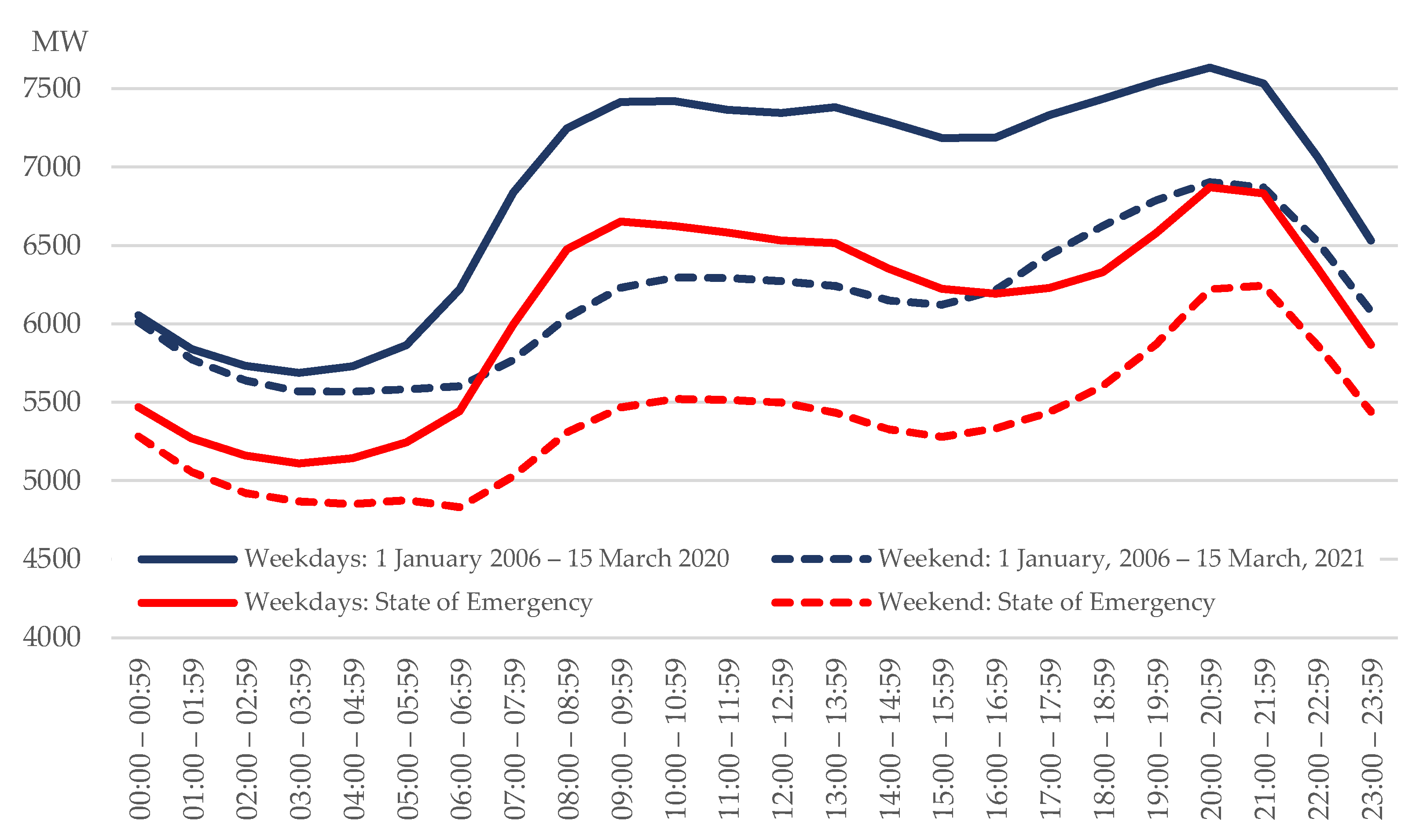
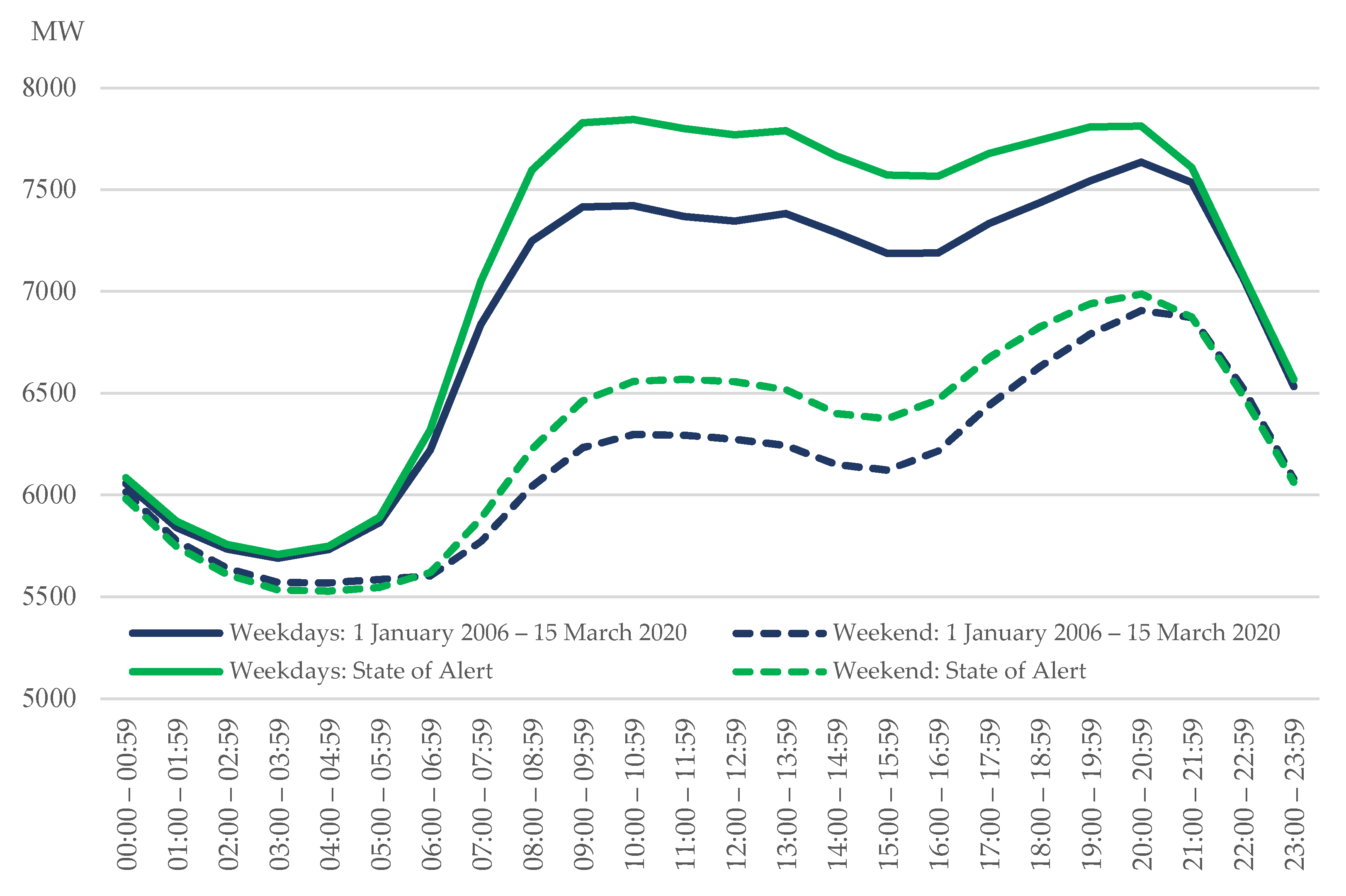
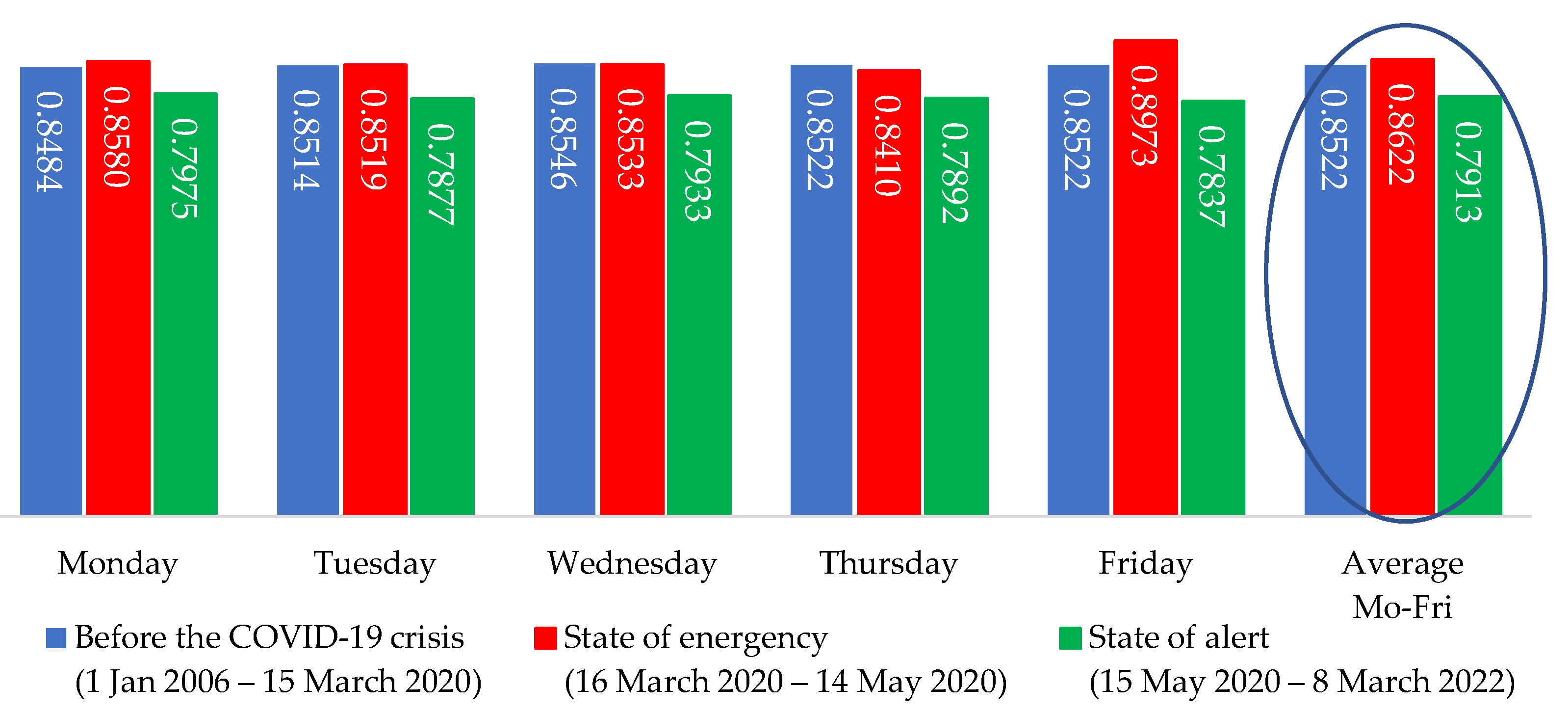
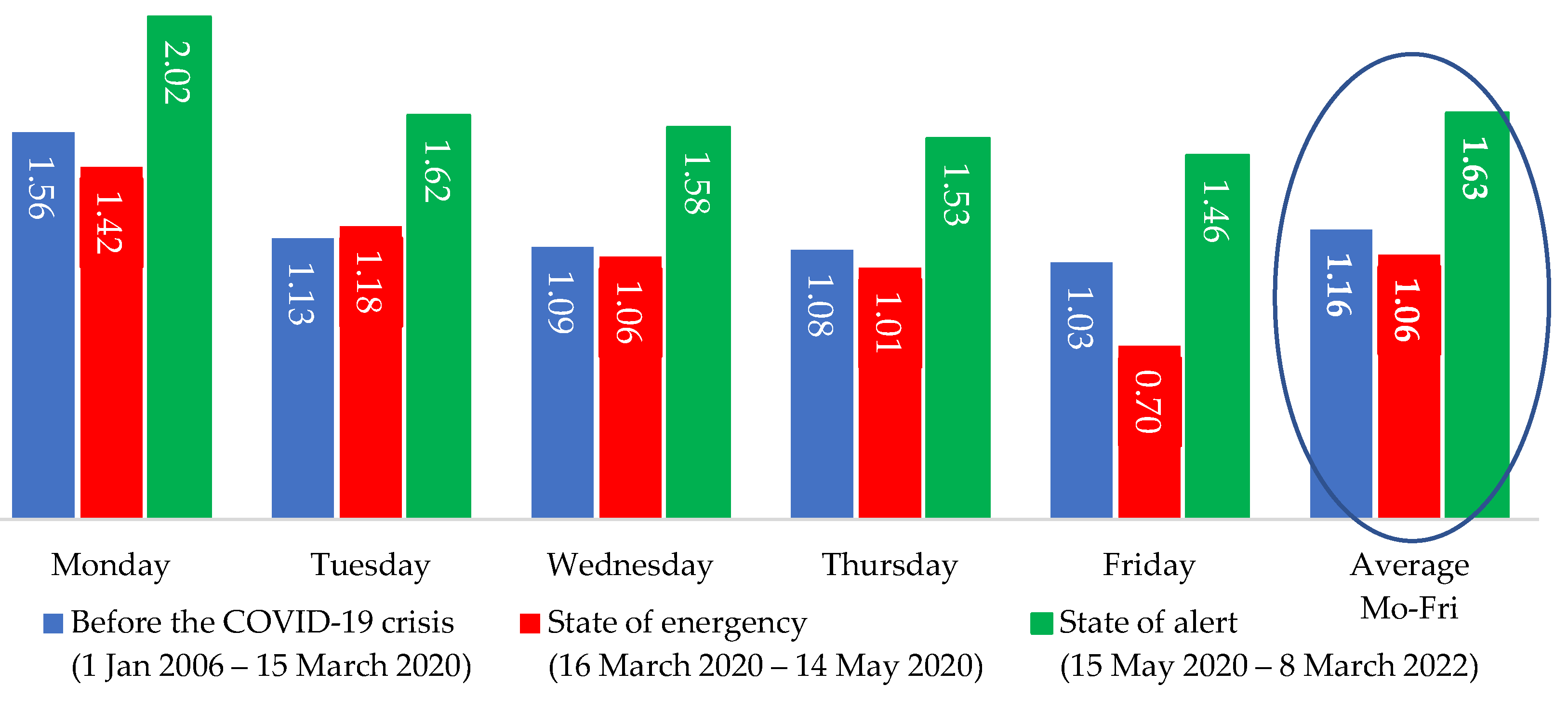
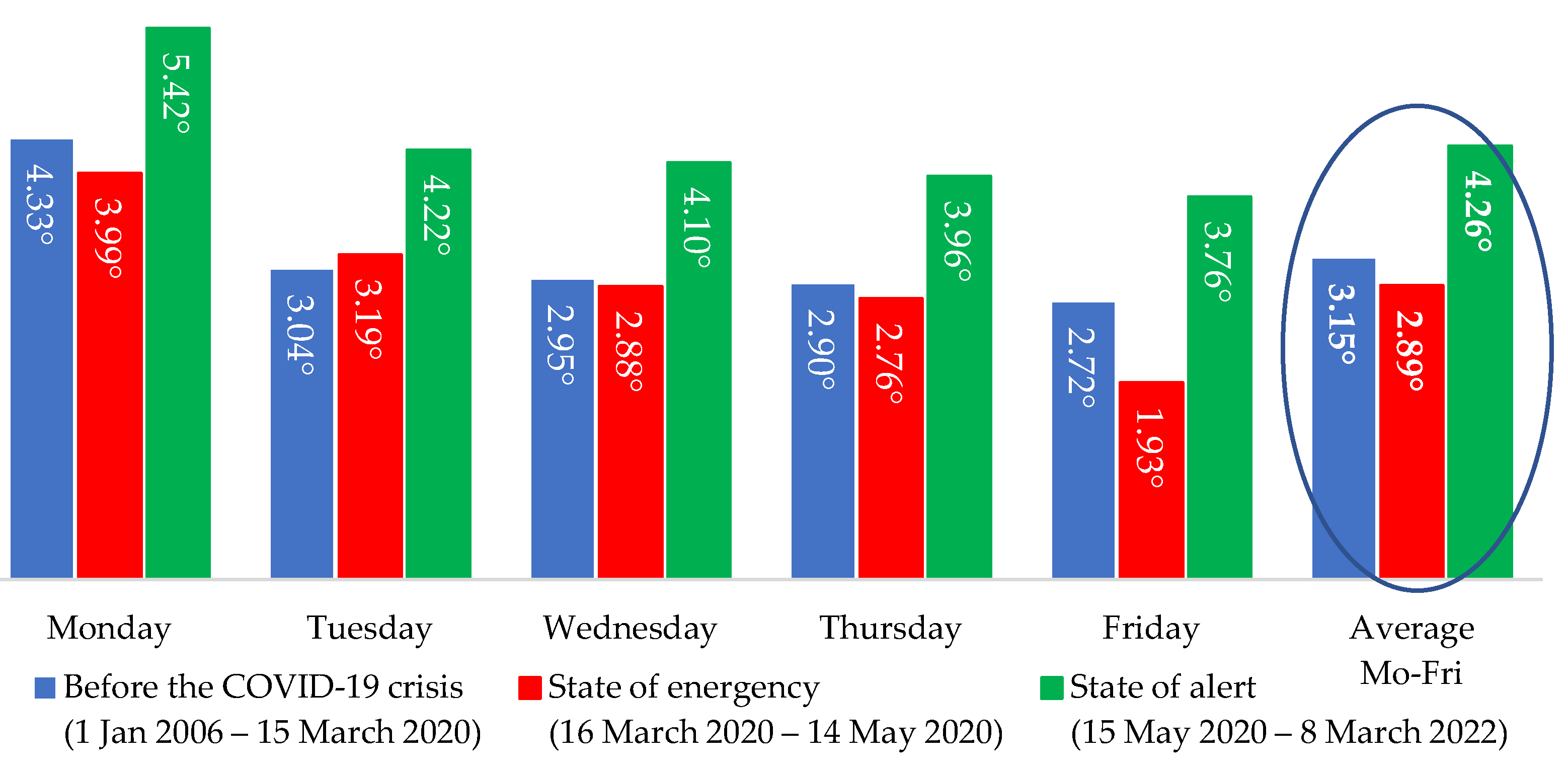
| Time Interval: All-Day | Monday | Tuesday | Wednesday | Thursday | Friday | Average Monday–Friday |
|---|---|---|---|---|---|---|
| The coefficient of correlation (values between −1 and +1, values closer to 1 representing stronger positive correlation) | ||||||
| 1 January 2006–15 March 2020 | 0.8484 | 0.8514 | 0.8546 | 0.8522 | 0.8522 | 0.8522 |
| 16 March 2020–14 May 2020 | 0.8580 | 0.8519 | 0.8533 | 0.8410 | 0.8973 | 0.8622 |
| 15 May 2020–8 March 2022 | 0.7975 | 0.7877 | 0.7933 | 0.7892 | 0.7837 | 0.7913 |
| The Manhattan distance (a smaller Manhattan distance suggests that two distributions are more statistically similar to each other) | ||||||
| 1 January 2006–15 March 2020 | 1.5555 | 1.1289 | 1.0949 | 1.0831 | 1.0326 | 1.1645 |
| 16 March 2020–14 May 2020 | 1.4164 | 1.1780 | 1.0551 | 1.0114 | 0.6958 | 1.0639 |
| 15 May 2020–8 March 2022 | 2.0191 | 1.6239 | 1.5760 | 1.5299 | 1.4631 | 1.6340 |
| The angle between the vectors of the structures (values between 0 and 90 degrees; the smaller the value, the closer the structures are) | ||||||
| 1 January 2006–15 March 2020 | 4.3267° | 3.0447° | 2.9461° | 2.8986° | 2.7209° | 3.1520° |
| 16 March 2020–14 May 2020 | 3.9923° | 3.1937° | 2.8807° | 2.7631° | 1.9342° | 2.8882° |
| 15 May 2020–8 March 2022 | 5.4179° | 4.2204° | 4.0987° | 3.9620° | 3.7608° | 4.2616° |
| The Weekdays’ Consummation in a State of Emergency Compared to: | Monday | Tuesday | Wednesday | Thursday | Friday | Average Monday–Friday |
|---|---|---|---|---|---|---|
| The coefficient of correlation (values between −1 and +1, values closer to 1 representing stronger positive correlation) | ||||||
| Average of weekend days | 0.8580 | 0.8519 | 0.8533 | 0.8410 | 0.8973 | 0.8622 |
| Saturday | 0.9311 | 0.9307 | 0.9297 | 0.9198 | 0.9472 | 0.9349 |
| Sunday | 0.7368 | 0.7249 | 0.7288 | 0.7144 | 0.8001 | 0.7413 |
| The Manhattan distance (a smaller Manhattan distance suggests that two distributions are more statistically similar to each other) | ||||||
| Average of weekend days | 1.4164 | 1.1780 | 1.0551 | 1.0114 | 0.6958 | 1.0639 |
| Saturday | 1.2351 | 0.9431 | 0.8266 | 0.7742 | 0.4974 | 0.8343 |
| Sunday | 1.6689 | 1.4764 | 1.3609 | 1.3234 | 0.9663 | 1.3516 |
| The angle between the vectors of the structures (values between 0 and 90 degrees; the smaller the value, the closer the structures are) | ||||||
| Average of weekend days | 3.9923 | 3.1937 | 2.8807 | 2.7631 | 1.9342 | 2.8882 |
| Saturday | 3.4171 | 2.5435 | 2.2329 | 2.1138 | 1.4248 | 2.2576 |
| Sunday | 4.6825 | 3.9508 | 3.6404 | 3.5256 | 2.6366 | 3.6362 |
| Mahalanobis Distances | ||||
|---|---|---|---|---|
| Average weekdays’ hourly profile of electricity real consumption in: | pre-crisis period | and Saturday | in pre-crisis period | 4.33 |
| and Sunday | 4.05 | |||
| and weekend average | 4.14 | |||
| state of emergency period | and Saturday | in pre-crisis period | 3.73 | |
| and Sunday | 3.52 | |||
| and weekend average | 3.57 | |||
| and Saturday | in a state of emergency period | 2.77 | ||
| and Sunday | 3.10 | |||
| and weekend average | 2.85 | |||
| state of the alert period | and Saturday | in pre-crisis period | 4.35 | |
| and Sunday | 4.12 | |||
| and weekend average | 4.19 | |||
| and Saturday | in the state of the alert period | 4.55 | ||
| and Sunday | 3.61 | |||
| and weekend average | 3.99 | |||
Disclaimer/Publisher’s Note: The statements, opinions and data contained in all publications are solely those of the individual author(s) and contributor(s) and not of MDPI and/or the editor(s). MDPI and/or the editor(s) disclaim responsibility for any injury to people or property resulting from any ideas, methods, instructions or products referred to in the content. |
© 2023 by the authors. Licensee MDPI, Basel, Switzerland. This article is an open access article distributed under the terms and conditions of the Creative Commons Attribution (CC BY) license (https://creativecommons.org/licenses/by/4.0/).
Share and Cite
Jula, N.-M.; Jula, D.-M.; Oancea, B.; Papuc, R.-M.; Jula, D. Changes in the Pattern of Weekdays Electricity Real Consumption during the COVID-19 Crisis. Energies 2023, 16, 4169. https://doi.org/10.3390/en16104169
Jula N-M, Jula D-M, Oancea B, Papuc R-M, Jula D. Changes in the Pattern of Weekdays Electricity Real Consumption during the COVID-19 Crisis. Energies. 2023; 16(10):4169. https://doi.org/10.3390/en16104169
Chicago/Turabian StyleJula, Nicolae-Marius, Diana-Mihaela Jula, Bogdan Oancea, Răzvan-Mihail Papuc, and Dorin Jula. 2023. "Changes in the Pattern of Weekdays Electricity Real Consumption during the COVID-19 Crisis" Energies 16, no. 10: 4169. https://doi.org/10.3390/en16104169
APA StyleJula, N.-M., Jula, D.-M., Oancea, B., Papuc, R.-M., & Jula, D. (2023). Changes in the Pattern of Weekdays Electricity Real Consumption during the COVID-19 Crisis. Energies, 16(10), 4169. https://doi.org/10.3390/en16104169







